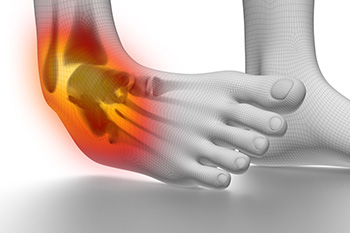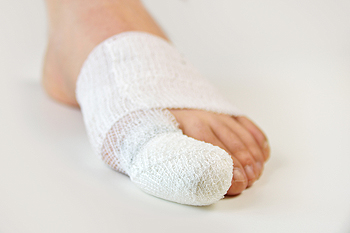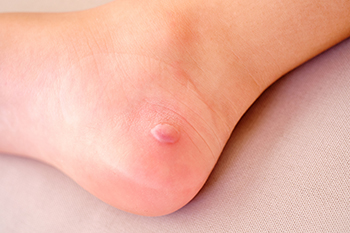Connect With Us
Blog
Items filtered by date: July 2025
Ankle Sprains and Podiatric Care

An ankle sprain occurs when the ligaments supporting the ankle stretch or tear, often caused by sudden twisting or rolling of the foot. This injury is common during sports, walking on uneven ground, or footwear that lacks adequate support. Causes include awkward landings or falls, while risk factors involve weak ankles, previous injuries, and poor balance. Symptoms of an ankle sprain include swelling, bruising, pain, and difficulty walking. A podiatrist can evaluate the severity of the sprain through examination and imaging, then develop a treatment plan that may include rest strategies, bracing, and custom orthotics. If you have injured your ankle, it is suggested that you promptly schedule a podiatry appointment to begin an effective treatment plan.
Ankle sprains are common but need immediate attention. If you need your feet checked, contact one of our podiatrists from Comprehensive Foot & Ankle Centers. Our doctors can provide the care you need to keep you pain-free and on your feet.
How Does an Ankle Sprain Occur?
Ankle sprains take place when the ligaments in your ankle are torn or stretched beyond their limits. There are multiple ways that the ankle can become injured, including twisting or rolling over onto your ankle, putting undue stress on it, or causing trauma to the ankle itself.
What Are the Symptoms?
- Mild to moderate bruising
- Limited mobility
- Swelling
- Discoloration of the skin (depending on severity)
Preventing a Sprain
- Wearing appropriate shoes for the occasion
- Stretching before exercises and sports
- Knowing your limits
Treatment of a Sprain
Treatment of a sprain depends on the severity. Many times, people are told to rest and remain off their feet completely, while others are given an air cast. If the sprain is very severe, surgery may be required.
If you have suffered an ankle sprain previously, you may want to consider additional support such as a brace and regular exercises to strengthen the ankle.
If you have any questions please feel free to contact our offices located in Shepherdsville and Louisville, KY . We offer the newest diagnostic and treatment technologies for all your foot and ankle needs.
Understanding Bunions and the Importance of Podiatric Care

A bunion is a bony bump that forms at the base of the big toe, as the top of the toe shifts inward. This condition often results from pressure on the foot over time, leading to joint misalignment. Common causes include improper footwear, genetics, flat feet, or certain medical conditions. Symptoms may involve pain, redness, swelling, and difficulty wearing shoes. Risk factors include family history, tight or narrow footwear, and occupations that place stress on the feet. A podiatrist can evaluate the severity, provide pain relief, recommend orthotics, and discuss treatment options. If you notice a growing bump or discomfort at the base of your big toe, it is suggested that you schedule a visit with a podiatrist who can offer effective relief and treatment solutions.
If you are suffering from bunion pain, contact one of our podiatrists of Comprehensive Foot & Ankle Centers. Our doctors can provide the care you need to keep you pain-free and on your feet.
What Is a Bunion?
Bunions are painful bony bumps that usually develop on the inside of the foot at the joint of the big toe. As the deformity increases over time, it may become painful to walk and wear shoes. Women are more likely to exacerbate existing bunions since they often wear tight, narrow shoes that shift their toes together. Bunion pain can be relieved by wearing wider shoes with enough room for the toes.
Causes
- Genetics – some people inherit feet that are more prone to bunion development
- Inflammatory Conditions - rheumatoid arthritis and polio may cause bunion development
Symptoms
- Redness and inflammation
- Pain and tenderness
- Callus or corns on the bump
- Restricted motion in the big toe
In order to diagnose your bunion, your podiatrist may ask about your medical history, symptoms, and general health. Your doctor might also order an x-ray to take a closer look at your feet. Nonsurgical treatment options include orthotics, padding, icing, changes in footwear, and medication. If nonsurgical treatments don’t alleviate your bunion pain, surgery may be necessary.
If you have any questions, please feel free to contact our offices located in Shepherdsville and Louisville, KY . We offer the newest diagnostic and treatment technologies for all your foot care needs.
Are You Suffering From Ingrown Toenails?
Shoes Can Affect Your Foot Health

Shoes can have a significant effect on the health of your feet, especially when worn for extended periods of time on hard surfaces. Inadequate support may increase stress on the heel and forefoot, potentially contributing to conditions like plantar fasciitis, calluses, or metatarsalgia. Shoes lacking proper cushioning or arch support may fail to distribute pressure evenly. Restrictive styles, such as high heels, can alter foot posture and lead to bunions, claw toes, or thickened nails. Foot pain can also result from wearing poorly fitted or overly rigid footwear, which interferes with natural foot motion and joint alignment. People engaged in sports should select shoes specific to that activity and that provide adequate shock absorption and lateral stability. Alternating shoes regularly helps reduce repetitive stress and allows structural materials to recover. Shoe inserts, when prescribed by a podiatrist, may help improve foot posture and alleviate pain. If you experience foot pain after wearing certain shoes, it is suggested that you schedule an appointment with a podiatrist for a diagnosis and treatment, in addition to guidance on how to choose proper footwear.
Getting the right shoe size is an important part of proper foot health. Seek the assistance of one of our podiatrists from Comprehensive Foot & Ankle Centers. Our doctors will provide the care you need to keep you pain-free and on your feet.
Getting the Right Shoe Size
There are many people who wear shoes that are the incorrect size, negatively affecting their feet and posture. Selecting the right shoes is not a difficult process, so long as you keep several things in mind when it comes to choosing the right pair.
- When visiting the shoe store, use the tools available to measure your foot.
- Be sure there is ‘wiggle room’. There should be about an inch between your toes and the tip of your shoes.
- Do not always assume you are the same size, as manufacturers run differently.
- Purchase shoes later in the day, as your feet swell as the day progresses.
- If a shoe is not comfortable, it is not suitable. Most shoes can’t be ‘broken in’, and comfort should be the ultimate goal when it comes to choosing the right pair of shoes
As our feet hold our body weight and keep us moving, it is important to treat them right. Picking the right pair of shoes can provide your feet comfort and mobility without pain.
If you have any questions, please feel free to contact our offices located in Shepherdsville and Louisville, KY . We offer the newest diagnostic and treatment technologies for all your foot care needs.
Managing a Broken Toe

A broken toe may result from a direct hit, such as stubbing the toe, dropping something heavy on it, or from repeated stress like running or jumping. Pain, swelling, bruising, and difficulty walking are common signs of a toe fracture. Some breaks can cause the bone to shift out of place, while others stay aligned but still cause discomfort. A broken toe may be open, with a wound that exposes the bone, or closed, where the skin remains unbroken. Ignoring the injury can lead to long-term problems, such as poor healing or joint stiffness. A podiatrist can check for bone displacement or hidden fractures using an X-ray or other imaging, as well as assess any risks of infection or complications. Depending on the type and severity of the break, a podiatrist may stabilize the toe with a cast, special shoe, or taping method. Surgery may be needed to realign the bone. If you have broken a toe, it is suggested that you promptly schedule an appointment with a podiatrist for an exam and appropriate treatment options.
Broken toes may cause a lot of pain and should be treated as soon as possible. If you have any concerns about your feet, contact one of our podiatrists from Comprehensive Foot & Ankle Centers. Our doctors will treat your foot and ankle needs.
What Is a Broken Toe?
A broken toe occurs when one or more of the toe bones of the foot are broken after an injury. Injuries such as stubbing your toe or dropping a heavy object on it may cause a toe fracture.
Symptoms of a Broken Toe
- Swelling
- Pain (with/without wearing shoes)
- Stiffness
- Nail Injury
Although the injured toe should be monitored daily, it is especially important to have a podiatrist look at your toe if you have severe symptoms. Some of these symptoms include worsening or new pain that is not relieved with medication, sores, redness, or open wounds near the toe.
If you have any questions, please feel free to contact our offices located in Shepherdsville and Louisville, KY . We offer the newest diagnostic and treatment technologies for all your foot care needs.
Fracture Blisters Need Prompt Attention

Fracture blisters are fluid-filled lesions that develop on the skin near a broken bone, usually in areas with little soft tissue such as the ankle or foot. These blisters form due to increased pressure and shearing forces during a traumatic injury. Common causes include severe fractures, particularly from high-impact incidents. Symptoms involve tense or blood-filled blisters, swelling, and pain. Risk factors include diabetes, vascular disease, and delayed medical attention. A podiatrist can assess the injury, prevent or treat an infection, and guide proper wound care and immobilization. Prompt evaluation ensures healing without complications. If you notice blistering near a foot injury, it is strongly suggested that you seek expert podiatric care immediately.
Blisters may appear as a single bubble or in a cluster. They can cause a lot of pain and may be filled with pus, blood, or watery serum. If your feet are hurting, contact one of our podiatrists of Comprehensive Foot & Ankle Centers. Our doctors can provide the care you need to keep you pain-free and on your feet.
Foot Blisters
Foot blisters are often the result of friction. This happens due to the constant rubbing from shoes, which can lead to pain.
What Are Foot Blisters?
A foot blister is a small fluid-filled pocket that forms on the upper-most layer of the skin. Blisters are filled with clear fluid and can lead to blood drainage or pus if the area becomes infected.
Symptoms
(Blister symptoms may vary depending on what is causing them)
- Bubble of skin filled with fluid
- Redness
- Moderate to severe pain
- Itching
Prevention & Treatment
In order to prevent blisters, you should be sure to wear comfortable shoes with socks that cushion your feet and absorb sweat. Breaking a blister open may increase your chances of developing an infection. However, if your blister breaks, you should wash the area with soap and water immediately and then apply a bandage to the affected area. If your blisters cause severe pain it is important that you call your podiatrist right away.
If you have any questions, please feel free to contact our offices located in Shepherdsville and Louisville, KY . We offer the newest diagnostic and treatment technologies for all your foot care needs.
Blog Archives
- August 2025
- July 2025
- June 2025
- May 2025
- April 2025
- March 2025
- February 2025
- January 2025
- December 2024
- November 2024
- October 2024
- September 2024
- August 2024
- July 2024
- June 2024
- May 2024
- April 2024
- March 2024
- February 2024
- January 2024
- December 2023
- November 2023
- October 2023
- September 2023
- August 2023
- July 2023
- June 2023
- May 2023
- April 2023
- March 2023
- February 2023
- January 2023
- December 2022
- November 2022
- October 2022
- September 2022
- August 2022
- July 2022
- June 2022
- May 2022
- April 2022
- March 2022
- February 2022
- January 2022
- December 2021
- November 2021
- October 2021
- September 2021
- August 2021
- July 2021
- June 2021
- May 2021
- April 2021
- February 2021
- January 2021
- December 2020

